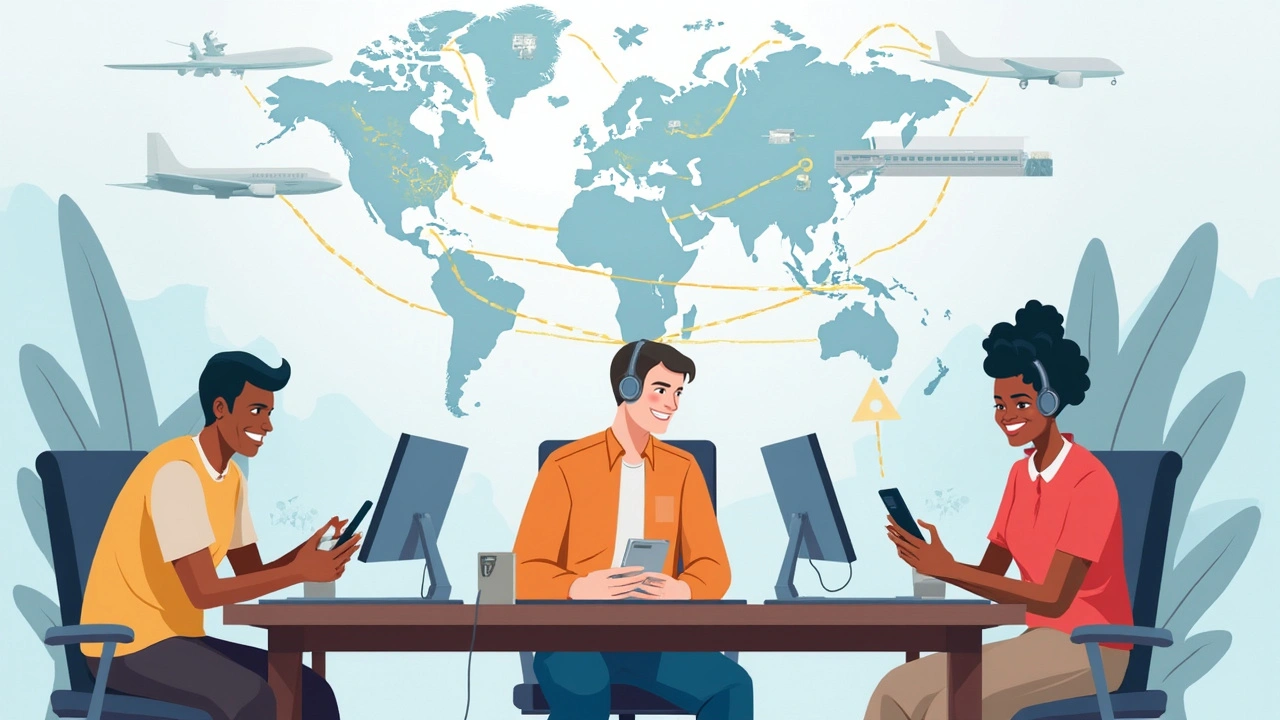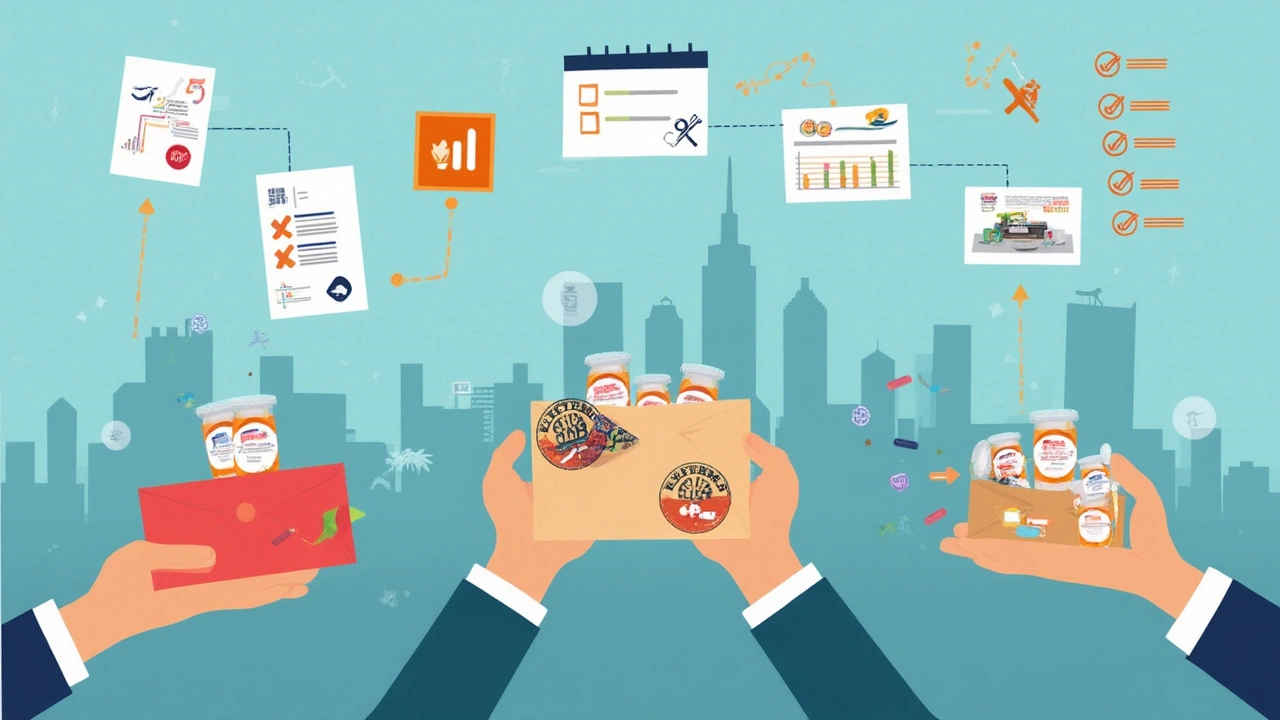Solving COVID-Era Shipping Delays for Cross-Border Medication Refills
 May, 24 2025
May, 24 2025
Imagine staring at an almost-empty pill bottle, knowing your medication should have arrived last week. No tracking update, no delivery van in sight, and your next refill feels like a race against the clock. That pulse of anxiety? It’s become way too familiar for anyone depending on cross-border meds since the pandemic began. Now it’s 2025, but those COVID-era shipping snags still haunt international mail like a stubborn cold.
The Current Cross-Border Shipping Reality for Meds
The world’s supply chains took a beating starting back in 2020, but what’s wild is how much the ripple effects still snag prescription deliveries—including from Canadian and overseas pharmacies. Flights that used to zip across the Atlantic every day? Still not at pre-pandemic levels. Ports and customs posts have new protocols, worker shortages, and in some places, rolling strikes. All this means that delivery timelines for international medications can swing from fast and predictable to slow and mysterious.
Online pharmacy sites usually quote a range for normal arrivals—say, 8 to 21 days for North America to the US. But if your last delivery landed at day 26, or never showed, you’re probably wondering what’s really running the show: weather, border checks, or plain old post-COVID backlog? In some big cities, local mail is getting sorted faster, but anything with a customs slip can curl up in a warehouse for two weeks just waiting for a stamp.
This chart sketches out recent stats for cross-border prescription shipments in 2024:
| Route | Pre-COVID Avg. (days) | 2024 Avg. (days) | Longest Delays (days) |
|---|---|---|---|
| Canada to US | 8-12 | 12-25 | 38 |
| UK/EU to US | 14-21 | 21-35 | 52 |
| India to US | 15-22 | 20-40 | 65 |
Meds aren’t just shipments—they’re lifelines, and a multi-week holdup can throw anyone’s treatment schedule into chaos. One frequent cause for delay? Enhanced screening for controlled substances, especially in the US since late 2023. Prescription packages are flagged for scanning, tracking and paper verification, and when you add holidays or bad weather, that 2-week window is just a wish.
Still, the demand for affordable international meds hasn’t dropped. Cross-border refills are especially crucial for folks managing chronic conditions who can’t afford high local US pharmacy prices. In my house, Ethan and I have had to plan months in advance for some of his specialty scripts. Stressful? You bet. But there are ways to cut that uncertainty down to something manageable.

Best Practices for Timely Prescription Refills
The old rule for mail-order refills—order two weeks ahead—just doesn’t cut it now. To avoid running out, smart patients are doubling or even tripling the padding time. Here’s what’s working in 2025, according to feedback from active international pharmacy users and real pharmacy shipping estimates:
- Order refills at least 45 to 60 days before your current supply runs out. Work backwards from your medication’s expiration date (and your insurance cycle, if you use one), to predict refill needs. Some people have started tracking their orders on spreadsheets or simple phone calendars to keep ahead.
- Split orders when possible. Instead of a single large order, try smaller, staggered ones from reputable sites. If one gets stuck in transit, the next may sail through.
- Choose trackable shipping every time—even if it costs a bit more. Many cross-border pharmacies now offer real-time location tracking, so at least you’ll know if your order is lost or just delayed in customs limbo.
- Ask your doctor for a 90-day prescription (or longer). Doctors understand the shipping drama and may write scripts for longer supplies, which helps you keep a bigger safety stockpile at home.
- Double-check your online pharmacy’s current delivery stats. They sometimes update shipping estimates for different US states or territories each month, depending on local bottlenecks.
- Opt in for delivery alerts, texts, or emails to get notified as soon as anything changes with your package’s status. Most reputable sites do this automatically if you register an account.
Don’t forget: not all cross-border pharmacy websites are created equal. A good starting point is checking out platforms that openly compare delivery timelines and reliability by route—like this helpful post on Canada drug shipping times. This way, you don’t have to trust anonymous forums or dated reviews for your peace of mind.
Speaking from experience—Ethan’s last heart medication reshipment did a 30-day ghost tour between Quebec and New Jersey, but because we’d split the order, the backup package arrived ten days later. There’s no shame in keeping your home pharmacy just a little overstocked. If you’re ever stuck, some people also ask their doctor for a short emergency fill at a local pharmacy until the international delivery lands. Insurers usually allow one-off “lost in mail” exceptions every couple years, but it’s worth checking your specific plan. A good rapport with your pharmacist and regular updates from your supplier are pure gold these days.

Adapting Plans: Tips and Tools to Stay Ahead of Shortages
The COVID-era didn’t just mess with travel and work; it basically remapped how people think about logistics in healthcare. Being proactive is the new baseline. Here are some next-level strategies that folks are using to dodge those dreaded "out of stock" and "shipment stuck" situations:
- Build a medication buffer. If your doctor allows it, gradually create a surplus supply by ordering early and filling your script at shorter intervals a couple times a year. This keeps you two to three months ahead, instead of scrambling with each order.
- Check your pharmacy’s online dashboard for real-time inventory or "backordered" warnings. Many top-rated international pharmacies update these daily, which can save your order from hitting a dead end due to supply interruptions.
- Join support groups online or on social media, where people swap shipping tips and spot early warning signs of bottlenecks on certain routes. Some savvy patients keep an eye on weather alerts, workers’ strikes, or major holidays in source countries, all of which can disrupt mail.
- Explore alternatives: If your usual route is slow (say, India-to-US), see if an EU or Canadian supplier stocks the same FDA-approved generic. Sites that publish multi-country sourcing options are proving invaluable in 2025.
- Don’t fall for overnight miracle delivery promises from new or shady sites. If a pharmacy claims to ship international meds in under a week, double-check licensing and read fresh reviews from real customers. Big promises rarely match reality, especially during global slowdowns.
- Use a credit card for online purchases so you can dispute a charge if something goes missing permanently. Reputable pharmacies will reship or refund if an order is genuinely lost past a certain time window.
- Stay flexible: consider switching to another brand or similar medication temporarily if a worldwide shortage hits. Doctors can often write a substitute while you wait out the delay.
Let’s drop some stats for context: According to a 2024 International Mail and Pharmacy Association survey, about 18% of all international medication shipments faced delays over 21 days between September and December 2023. Surprisingly, only about 2.5% of orders never arrived at all—so most are just late, not lost. If you’re wrestling with timing, remember it isn’t just you—pharmacies and shippers are fighting the same battle behind the scenes, juggling inventory, backlogs, and ever-changing customs rules.
Technology is lending a hand too. Some pharmacies offer refills by secure app, allowing you to upload new prescriptions, get status alerts, and confirm your shipment in a couple of taps. Voice assistants and SMS reminders are turning into lifesavers for people who manage multiple meds a day—especially if you’re juggling refills for your whole family. There’s a satisfaction in knowing that even if a package is stuck in Chicago for a week, you’ll get a ping as soon as it budges.
COVID-era shipping delays have forced everyone—patients, doctors, pharmacists—to think more like logisticians. The more you lean into planning, tracking, and communicating, the less those delays control your health (and your nerves). Stay curious, try out new tools when you find them, and give yourself plenty of wiggle room. The world’s supply chain drama may not calm down soon, but your prescription game doesn’t have to suffer for it.

Monika Wasylewska
May 27, 2025 AT 02:54Been there. Ordered my insulin from India last year-took 51 days. I kept checking the tracking like it was a weather forecast. Turns out, it was stuck in customs because they thought it was 'suspicious powder.' I swear, if I had a dollar for every time my meds got mistaken for contraband, I could’ve paid for the whole shipment twice.
But here’s the thing-I stopped panicking. Started ordering 60 days out. Now I’ve got a little stash under the sink. Feels weird, but peaceful.
Also, never trust a site that doesn’t show real-time customs status. If they’re hiding it, they’re hiding something.
Jackie Burton
May 27, 2025 AT 21:30Let’s be real-this isn’t ‘shipping delays.’ This is a coordinated effort by Big Pharma and the FDA to force Americans into overpriced domestic prescriptions. The ‘enhanced screening’? That’s just a euphemism for blocking cheap meds from abroad. They don’t care if you die of hypertension because your $3 pill got ‘delayed.’ They care about profit margins.
And don’t get me started on the ‘reputable pharmacies’-most of them are shell companies with fake Canadian licenses. The DEA’s been quietly flagging these for years. You think you’re saving money? You’re getting scammed with counterfeit pills.
Read the fine print. Look up the pharmacy’s license number. If it’s not on the NABP list, it’s a trap.
Philip Crider
May 29, 2025 AT 01:42Brooo. I just wanna say-this whole thing is wild. Like, imagine if your antidepressants got stuck in Chicago because some guy in a hoodie thought the bottle looked like a bomb. 😅
My mom’s been ordering her blood pressure meds from Mexico for 5 years. She uses a tracker, yeah, but also she calls the post office every Tuesday like it’s a therapy session. ‘Hi, is my little pill package okay?’
And honestly? I think we need a ‘Medications Are Not Contraband’ meme campaign. Like, a cat holding a pill bottle with ‘I’m not a drug, I’m a life.’
Also, 90-day scripts are a GAME CHANGER. My doc just wrote me one last month. Felt like I won the lottery.
Also also-emoji for everything. ❤️💊
Diana Sabillon
May 30, 2025 AT 00:08I just want to say thank you for writing this. I’ve been too scared to talk about how much anxiety I feel waiting for my meds. It’s not just about the pills-it’s the silence. No updates. No calls. Just… nothing.
When my last shipment was delayed for 37 days, I cried in the pharmacy aisle. Not because I was out, but because I felt so alone in it.
People don’t realize how much emotional labor goes into managing chronic illness when the system doesn’t work. You’re not just a patient-you’re a logistics coordinator, a detective, and a negotiator all at once.
I’m so glad someone finally said it out loud.
neville grimshaw
May 30, 2025 AT 01:30Oh, for god’s sake. We’re still talking about this? It’s 2025. We have drones, AI, and quantum computing-but my insulin is still getting ‘lost’ in a warehouse in Ohio because someone forgot to file Form 7B-3 in triplicate?
It’s not a ‘delay.’ It’s a national disgrace.
And don’t even get me started on those ‘reputable’ Canadian pharmacies. Half of them are run by guys in basements with a printer and a PayPal account. I’ve seen the receipts. One had a logo that looked like it was made in MS Paint.
Meanwhile, I’m sitting here with my 90-day script, a spreadsheet, and a prayer. Welcome to the future, folks. It’s beige, bureaucratic, and deeply, deeply sad.
Carl Gallagher
May 30, 2025 AT 18:49It’s fascinating how the pandemic didn’t just disrupt supply chains-it exposed the fragility of healthcare logistics as a whole. What we’re seeing now isn’t a temporary glitch; it’s the result of decades of underinvestment in cross-border pharmaceutical infrastructure, compounded by post-COVID labor shortages, regulatory fragmentation, and the commodification of health.
People talk about ‘ordering early’ like it’s a personal responsibility, but the real issue is systemic. Why should a diabetic in Ohio have to become a customs expert just to access a generic version of a drug that’s available in Bangalore for 1/10th the price?
And yet, the solution isn’t just more bureaucracy. It’s interoperability: real-time customs data sharing, standardized digital prescriptions, and international recognition of pharmacy licensing. We have the tech. We just lack the political will.
Until then, yes-order early, track everything, and keep a buffer. But don’t mistake personal adaptation for systemic progress.
bert wallace
June 1, 2025 AT 14:48My cousin in Scotland had his blood thinner stuck for 48 days last year. Turned out it was held because the label said ‘tablet’ in English but the batch number was printed in Cyrillic. No one knew why. No one cared.
He finally got it after his GP called the UK’s Medicines and Healthcare products Regulatory Agency. They sent a form. It took two weeks to process. The meds arrived the next day.
Point is: if you’re desperate, call the regulator. Not the pharmacy. Not the post office. The regulator. They have power. Most people don’t know that.
Also-don’t trust ‘trackable shipping’ if the tracking link just says ‘in transit’ for three weeks. That’s not tracking. That’s a lie.
Neal Shaw
June 2, 2025 AT 23:57There’s a critical gap in the data here. The 18% delay rate cited applies only to shipments that were successfully tracked. But what about the 5-7% of packages that disappear entirely without a trace? Those aren’t reflected in the stats.
Also, the assumption that ‘most are just late, not lost’ is misleading. Many delayed packages are functionally lost-meds expire before delivery, or patients are forced to refill locally at exorbitant cost, rendering the original order irrelevant.
Furthermore, the rise in ‘FDA-flagged’ shipments correlates directly with increased use of generic antihypertensives from India. This isn’t about safety-it’s about protecting domestic market share.
Recommendation: advocate for a national ‘Medication Import Transparency Act.’ Require real-time customs data feeds to patient portals. Make delays visible, accountable, and reportable.
Hamza Asghar
June 4, 2025 AT 09:06Oh wow. So you’re telling me people are actually surprised that their $3 pills from India take 65 days? What did you expect? You think the US government wants you to save money? LOL.
And ‘split orders’? Cute. That’s not a strategy-that’s a desperate Hail Mary. You think the system doesn’t know you’re doing that? They’re watching. Every single package gets flagged if it’s from a ‘high-risk’ country.
And ‘90-day scripts’? Sure, if your doctor’s not gonna get audited by Medicare for ‘overprescribing.’
Real talk? If you’re relying on overseas meds, you’re playing Russian roulette with your health. Counterfeits. Expired batches. Unregulated ingredients. You think your ‘trusted site’ is legit? Check their domain registration. 90% of them were created last year.
Stop romanticizing this. This isn’t ‘smart patient behavior.’ It’s a broken system forcing you to gamble with your life.
Karla Luis
June 4, 2025 AT 10:26